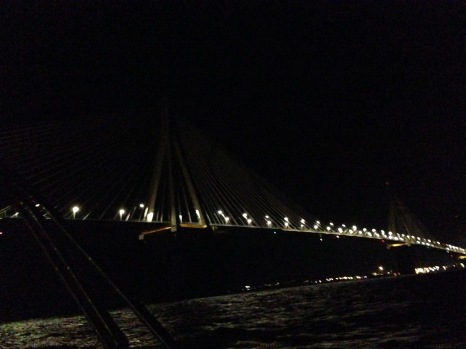The Rio-Antirrio Bridge is a spectacular crossing that links the town of Antirrio in the south to Rio in the north spanning the Gulf of Corinth just east of Patras. It is widely regarded as one of the engineering marvels of the modern age. Not only is it beautiful, as can be seen from the pictures below, it has been constructed to accommodate a number of features of the area around Corinth which combined to make the design and engineering a problem of unprecedented complexity.
There are of course the usual problems of cantilevered bridges such as wind, heat expansion etc. but this bridge had to cope with three other very significant factors. The first was that the Isthmus of Corinth to the south is actually moving away from the north at a rate of 1.6cm per year and is tilting upwards at the rate of 1mm per year, so the bridge has to be able to cope with this separation in the period of its lifetime.
The second is the constant threat of seismic disruption through earthquakes. This part of Greece is notorious for seismic activity, for example the earthquakes in Kefalonia which brought devastation to that island in the early 1950s and also during the Second World War, so the bridge had to be built on platforms which would act as dampers in the event of earthquakes! It is actually floating. How do people work these things out?
The third, and for me the strangest, hazard is that of potential tsunamis. The Gulf is quite narrow and the concern is that in the event of an earthquake the shock wave would create a surge either into or out of the narrow opening spanned by the bridge, bringing the whole thing down.
It is stunningly beautiful and Ruth and I were lucky enough to be on the pre-midnight watch and from some eight miles off we were able to view the orange and blue glow outline of the pillars as they slowly grew in the lens of the binoculars.
John came on watch just before midnight and we were babbling on about how spectacular the lights were and how awesome the bridge looked even from this distance. So we all turned to have a look ….. and it was gone! One minute it was there, the next it disappeared. Obviously, I suggested, they must turn off the lights at midnight. John looked at us both with a worried expression on his face. So we did not get to see the bridge in all her luminous glory and that had some relevance later.
Now I hear you say ” well that’s a big bridge, no trouble getting under that”. Think again. There is a very strict protocol for passing under the bridge. Commercial vessels pass under the high bit where there is some 55 meters of clearance. We lesser mortals have to go around the side where clearance gets to as low as 25 meters. Lothian Sky’s mast (including the VHF antenna is 22.5 meters from the water line. Too close for my comfort. What if someone had left something dangling over the side? Or, they had road subsidence or a bolt came loose? You laugh, but only two months after it opened one of the main suspension cables snapped on the north pillar!
Alan had to call in to the bridge control the length of the boat and the height of the mast and was then given instructions on which part of the bridge to go under. Not understanding at the time the significance of the tolerances and the margins of clearance I had told Alan that the mast was 21 meters – it was only afterwards that I checked the boat specification to realise that I was 1.5 meters short!
The photo below is taken looking west so we were approaching from the left side of the bridge as we look.
So numbering from the left in the above photograph we had to pass between pillars one and two. Looks OK, doesn’t it? Not if you are standing on the deck of your brand new boat in almost pitch darkness apart from the street lights on the bridge, watching some seriously sturdy metal girders reaching down to wrench your mast from its bearings, and wondering why the top of the mast looked so much nearer than we expected. Closer and closer we came and not a sound was heard from any of the crew, not even Alan. John said that he actually stepped to the side to give the mast free room to crash onto the deck! I think he was concerned that he might get blood on the deck. Such a gentleman!
Was it close? It looked it, but in the dark it is difficult to judge distance. We looked, we listened and we felt no shuddering grinding that would have signalled the end of Lothian Sky. John’s entry into the log at 0200 sums it up, “Passed under the Patras bridge – mast intact!”

So this picture was taken after we had passed under the bridge and as you can see we did not go particularly near to pillar number 2!
The really curious part of it all for me was that Lothian Sky was the only vessel within several miles of the bridge. We could have gone through at any point, back and forward a couple of times, sideway even, and would not have hindered any other shipping. But it was 2 O’Clock in the morning and I reckon the bridge control boys were bored. Nothing like putting the shits up a group of merry matelots to lighten up the night shift.
Fairwell to the beautiful Rio-Antirrio Bridge. Forward to the Corinth Canal.



I was wondering at what point it would be too late to abort!!! Beautiful pictures!
LikeLike
The same thought was in my mind but I couldn’t say anything ’cause I was holding my breath!
LikeLike